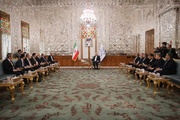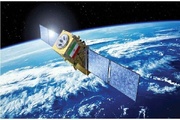The Magi
The Magi were astrologers and probably came from
Which star did the Magi follow?
In ancient astrology, the giant planet Jupiter was styled as the King's Planet, representing the highest god and ruler of the universe: Marduk to the Babylonians; Zeus to the Greeks; Jupiter to the Romans. The ringed planet Saturn was deemed the shield of
The astronomer Kepler noted in the early 17th century that every 805 years, Jupiter and Saturn come into conjunction, with Mars joining the configuration a year later. Since Kepler, astronomers have computed that for ten months in 7 BC, Jupiter and Saturn traveled very close to each other in the night sky, and in May, September, and December of that year, they were conjoined. Mars joined the configuration in February of 6 BC.
The Chinese had more exact and more complete astronomical records than the astrologers of the
The star that the Magi followed -- the Star of Bethlehem -- could be any of the astral markers that appeared in 6, 5, and 4 BC.
The shepherds
Luke 2:8: "And there were shepherds living out in the fields near by, keeping watch over their flocks at night."
In
The Bible does not mention the celebration of Christ's birthday, and the early Christians seem not to have celebrated his birthday. However, to avoid persecution, they would hang holly on their doors during December just as the Roman pagans did for Saturnalia, their feasts honoring their god of harvest. Likewise, in September, during the Jewish Feast of Trumpets (modern-day Rosh Hashanah), they would borrow some of the custom to protect themselves, carrying on with their own customs behind closed doors. This added to the speculation that early Christians celebrated the birth of Christ in September. It is noted that
The dating of the founding of
In the 6th Century CE, the Roman monk-mathematician-astronomer named Dionysis Exeguus (Dionysis the Little) reformed the calendar to pivot around the birth of Christ. He dated the Nativity 753 years from the founding of
Herod, who ordered all the babies in
Early Christians appear not to have celebrated the birth of Christ. In fact, Christmas became widely popular only in the 19th Century.
Christmas Today
The reference to the birth of Jesus 2005 years is wrong in two ways: a. there was no year 0, thus we have had only 2004 years since Dionysis (incorrectly) calculated the year of the Nativity. b. Dionysis's calculation was off by at least 5 years, as mentioned above.
In the year 274 CE, solstice fell on December 25th, and Roman Emperor Aurelian proclaimed the date as "Natalis Solis Invicti," the festival of the birth of the invincible sun. In 320 CE, Pope Julius I specified the 25th of December as the official date of the birth of Jesus Christ. In 325 CE, Constantine the Great, the first Christian Roman emperor, introduced Christmas as an immovable feast on December 25. In 354 CE, Bishop Liberius of
In some parts of the
Merry Christmas!
The most likely year that Jesus was born is 6 BC, probably in the month of March. There was no year 0 (zero) recorded, so the 2nd millennium celebration of the birth of Jesus should have been held in March 1995. But considering that Nativity was not celebrated at all for the first 300-or-so years, and that Christmas became widely popular only in the 19th Century, it remains remarkable that the birthday of Jesus Christ today is one of the biggest industries in the world. A rather apt acknowledgement.
Have a wonderful Merry Christmas and a loving, peaceful, and prosperous New Year 2006.
(Source: www.tf.jcu.cz)



















Your Comment